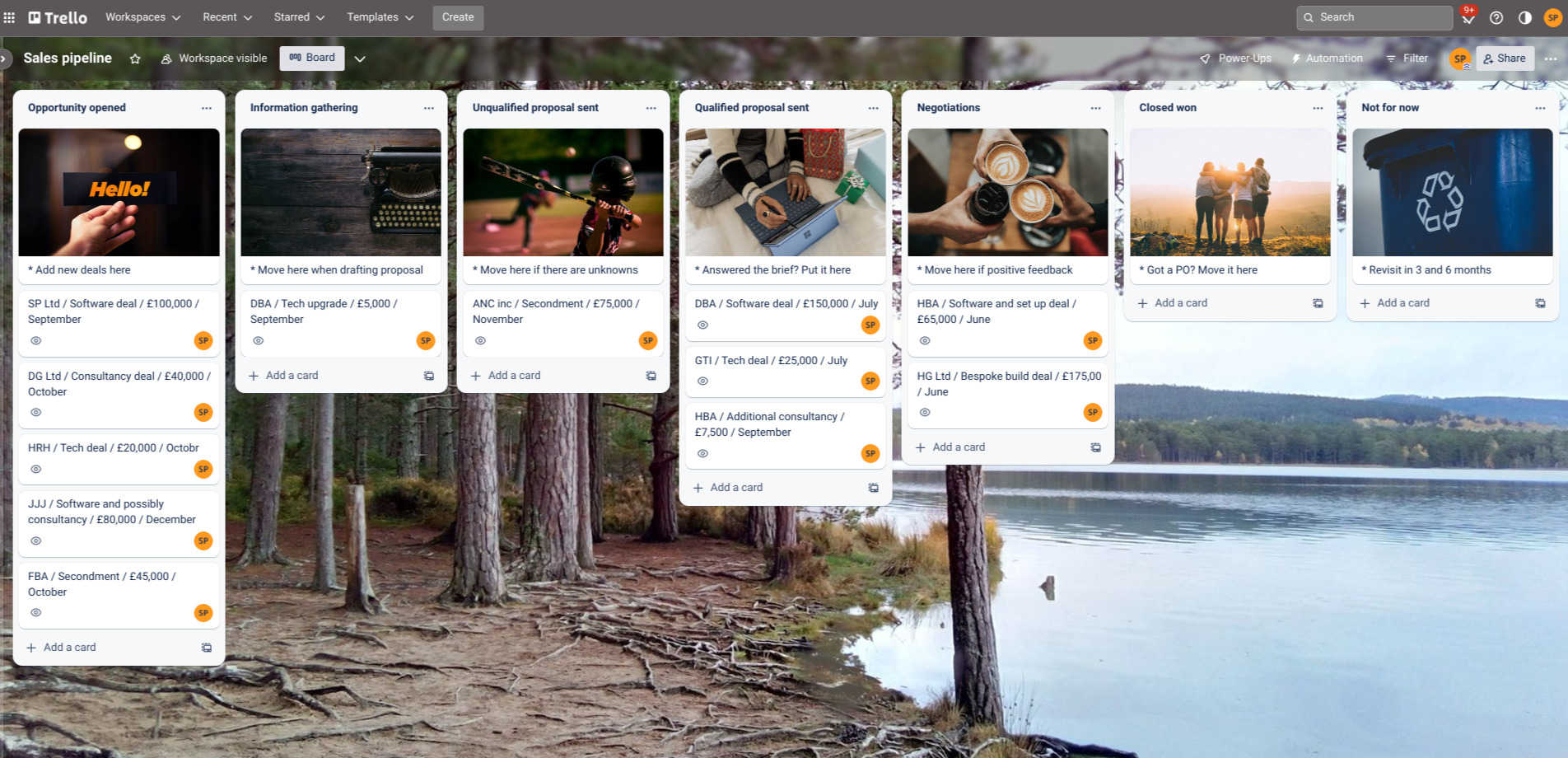The sales pipeline meeting
The humble sales pipeline meeting can be the source of one of the most simple but effective BD upgrades.
Put simply, done well the sales pipeline meeting keeps the machine going and ensures no opportunities are left wanting. Done badly, it leaves money on the table and could be the difference between success and failure.
In my experience, even the smallest and self-perceived simplest of businesses can drive substantial benefit from taking the sales pipeline meeting seriously. However, what is commonly found is that this regular session is either a bit of a talking shop among the more extroverted team members, or at worst the most dreaded recurring meeting on the calendar.
What are we talking about here?
In this context, the sales pipeline meeting is defined as a regular session going through live current deals, assessing their status, next steps, identifying potential blockers and discussing resolutions.
How often should it be? In a B2B business, with say at least 20 or 30 live deals at any one time, then it should take place at least every two weeks, if not weekly.
Like any well run meeting, the sales pipeline meeting benefits from a clear agenda. The participants need to hold themselves to account to keep on topic and not let the chat deviate away from the core discussion. It is important that the attendees have the confidence and the safety to push back on deviations away from the main mission.

Book now to give your business a health check
Our health check will shine a torch around the inside of your sales and marketing set up.
We will identify frictions and highlight what support would help.
Whipping it into shape
Running the sales pipeline meeting on a spreadsheet doesn’t cut it. Why? It is too static and not sufficiently visual to create a sense of priority and action.
Let me unpack that a little. Having an excel with a set of columns like ‘deal name,’ ‘deal value,’ ‘lead contact’ and ‘comments’ can only give a snapshot of a point in time. This is not enough. Deals develop over time, they grow, they hit objections, they pull in other people etc. Ah but… it could be argued that updating the ‘comments’ column is enough to keep things on track. Nope. It doesn’t work. It completely fails to give that rich history over time of deal communication. Come the crunch moment, you could easily end up on the phone or in a meeting and not know crucial information that would help get the deal over the line. Perfectly good deals have died on a spreadsheet.
The other danger of running deals on a spreadsheet is bloat. What I mean by this is that all deals are up there on the listings, whether they are current, long since lost or even won. Having a busy spreadsheet is a kind of comfort blanket. Busy sheet = busy pipeline, right? Well… not if half of it is dead. Instead, be honest, focus on the live stuff and if its looking quiet, acknowledge the fact there aren’t enough deals in play. Otherwise, it’s just vanity.
Let go of the spreadsheet
Hopefully, I’ve convinced you that deal management by spreadsheet isn’t fit for purpose.
But… I hear you say, we don’t have some fancy pants CRM (yet) in our business and we’re not prepared to invest in one just for the sake of the regular sales meeting.
OK fine. Let’s use some free tools that will show the benefits of a more dynamic and visual methodology without having to fork out a single penny. A free Trello account and some single board guest invites (also free) are all you need to get started.
Going down this route will enable a more visual board which gives an instant sense of which deals are making progress through the pipeline and on their way to becoming new projects. Deals can be assigned owners, history can be added in chronological order and links to key documents an be added in situ. What this means is that as deals develop it is a simple case of either adding some text or dragging and dropping the card to keep things accurate.
Of course, there are limitations to the free option. It’s not possible to create weighted and actual pipeline £ totals and there is not a completely seamless flow of information between the deal, the account and the wider individuals in the target organisation.
Here is the Make the Break template for a vanilla install when it comes to using Trello instead of spreadsheets for the sales pipeline meeting.
Set the board up with seven lists across the top with the following headings:
- Opportunity opened (10%)
- Information gathering (15%)
- Unqualified proposal sent (20%)
- Qualified proposal sent (50%)
- Negotiations (75%)
- Close won (100%)
- Not for now (0%)
Then add individual deals with a consistent naming format. For example:
Company name / Deal name / Value / Expected decision date
Every deal has a lead in your organisation. This person is both responsible for driving the deal itself and for talking through the deal update in the meeting. They can be added to the card with their initials appearing in the top corner.

In the meeting
By creating this set up, the chair of the sales pipeline meeting can do some on the fly simple filtering. For example by stage, owner, account name. It is also super clear which deal is the whopper, the £ value is right there in the title of the card.
What does each definition mean? What is the trigger for a lead moving on to the board as ‘opportunity opened?’ There is no one-size fits all answer here, there’s subtlety and nuance that will change from business to business.
This is all super basic stuff. Moving to a CRM can bring a multitude of benefits that far outweigh the investment. A proper CRM can help bring all the prospect data into one place, keep it clean and secure, have a full contact history, display weighted pipeline, be the launchpad for campaigns, highlight under served accounts and give leadership confidence for hiring decisions based on the strength of pipeline and what is likely to land in the next 3 months.
There are many CRM software options out there. There’s also DIY options via the likes of Airtable or the custom development route. For most small businesses, the big name CRM providers are more than capable of coping and flexing to the demands being asked of them. They are typically well set up to integrate with other software e.g. finance and marketing automation tools. Here at Make the Break we have experience of working with many providers and we really like HubSpot.
Sales pipeline, meet the real world
Of the six deal stages proposed, one of them may strike you as a little odd compared to the others. The ‘unqualified proposal sent.’
Here’s the thing. In the ideal world there would never be an unqualified proposal sent. Every deal would be well qualified, there would be no unknowns and the proposal would answer all the questions and cover all the bases.
But the real world doesn’t work like that. In reality, there are times when you are just making up the numbers and one of several responding to the RFP. Sometimes the deal has come to your business via a middle third party and you might not even know who the end client is yet. And then there are those times when it’s more painful than that and the only access you have into the prospect organisation doesn’t know the full picture and there isn’t yet a wider relationship to work with.
That’s sales. You just have to work with what you’ve got. In the real world there will be unqualified proposals on the board. The task for the team is to keep the numbers of unqualified’s down and get them either shifted to qualified as soon as possible, or killed off because they are never going to come your way.
Sales pipeline meeting format, follow the money
How the meeting is chaired is also important to making it effective. The temptation here is to take a chronological approach to the deals. Start with the top left of the board – the most recently added deal in ‘opportunity opened.’
Instead, start with the deals in ‘negotiations’ and work backwards.
Why? Well, there’s good reasons for this. At the start of the meeting, everyone is focused and ready to give it their all. By the end, people are dropping off to join the next meeting or have to cover the final points at a fast pace to prevent the session from overrunning. It’s a mistake to leave discussing the deals that are closest to winning until the very end.
Start with ‘negotiations,’ then go through each of ‘qualified proposal sent,’ ‘unqualified proposal sent,’ ‘information gathering’ and ‘opportunity opened.’
If the meeting is time pressured towards the end, it is much easier as a group to whizz through the highlights of new deals. Better that than rushing those that are in the critical negotiation stage.
The task of the chair is to make sure the deal owner has highlighted any potential blockers and set a clear next action with a due date. All of which is to be added to the card or CRM.
Bringing it all together
A well run sales pipeline meeting is a valuable thing. It can foster high quality collaboration across the team, it can give leadership a true picture of what is going on commercially and can help forward communication to the delivery team by having an accurate picture of what is likely to be coming their way.
While the suggested deal stages listed here are by their nature generic, beware the overly complex multi-stage sales pipeline. I’ve yet to see an example where adding many more deal stages created significant value. The more likely scenario is it just introduces unnecessary complexity into the business.
In addition to this regular session, it is also useful to communicate the monthly and quarterly figures. These headline figures are typically number deals in the pipeline, weighted values, new business booked, repeat business, total sales, MRR and so on…
If the sales pipeline meeting is being done well then the monthly communication could easily be a Slack or Teams message. One less meeting in the calendar every month and some time back for the team to get on with the task at hand. Happy days.
